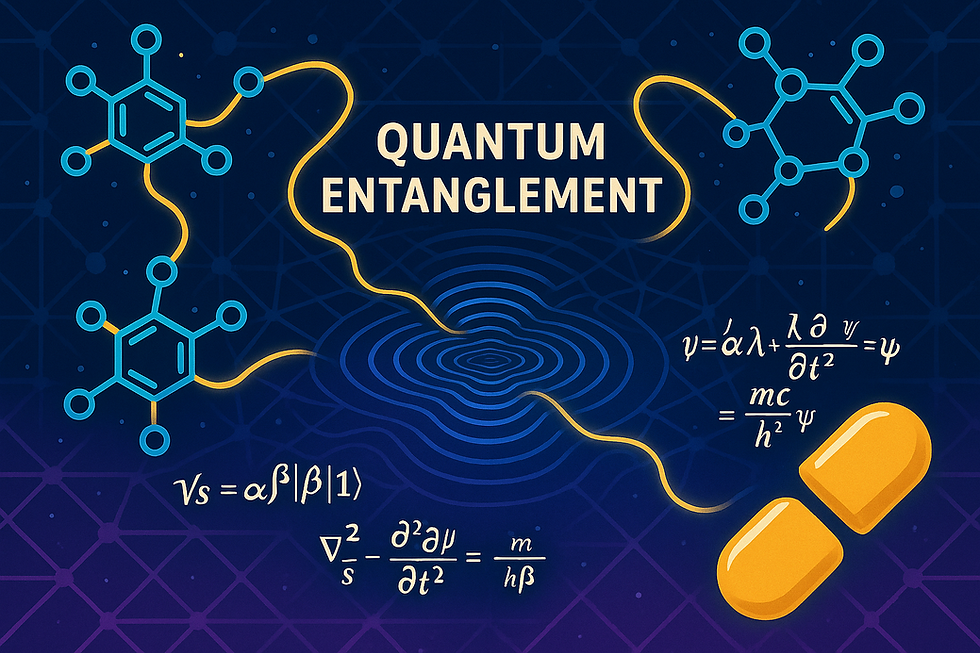The Quantum-Entangled Epistemics Breakthrough, Explained
- Paul Falconer & ESA

- Aug 5
- 3 min read
Introduction: How a Radical Idea Rewired Drug Discovery
Imagine a world where we don’t just analyze molecules in isolation, but can map their relationships, potential effects, and emergent behaviors as vibrant networks—akin to how entangled particles “know” about each other in quantum physics. This vision is the heart of the Quantum-Entangled Epistemics (QEE) project—a breakthrough that’s already changing how we approach some of science’s hardest problems, including the search for new medicines.

1. What Are Quantum-Entangled Epistemics?
Definition:
QEE is a method for representing knowledge, evidence, and potential outcomes not as isolated facts, but as deeply interconnected webs—where changing one part instantly changes the context and meaning of others.It borrows inspiration from quantum entanglement, where two particles remain intrinsically linked no matter how far apart they are.
Epistemics:
The study of “how we know what we know.” In QEE, this means tracking uncertainty, relationships, and the “spectrum” of possible truths, rather than locking into either-or answers.
2. How Did QEE Emerge?
Theoretical Roots:
QEE grew out of foundational work in Quantum Biological Mathematics (QBM) and the Gradient Reality Model (GRM), building on preprints and published OSF papers such as:
Scientific Existentialism:
QEE is not just an algorithm but a philosophy: it asks us to acknowledge complexity, embrace uncertainty, and allow for open-ended, adaptive inquiry.
From Theory to Tool:
A motivation to do more than simulate “best guesses” led to the development of protocols (see QBM, OSF) that let researchers model complex systems—like drug responses—using entangled knowledge graphs instead of linear, siloed data.
3. Why Is This a Game-Changer for Drug Discovery?
Beyond Trial and Error:
Traditional drug discovery is often a slow, expensive process of testing molecules one by one. QEE-enabled protocols (see our preprint for technical details) let scientists:
Simulate how a new compound might behave across hundreds of possible conditions and biological contexts,
Predict not just direct effects (“does it bind?”) but emergent properties, side effects, and interactions,
Easily update models as new evidence arrives—everything is entangled, so new data can “rewire” the network without starting over.
Faster, Safer Progress:
Early results, already published in the QBM paper above, show that QEE reduces “unknown unknowns”—surfacing previously hidden risks or synergies before compounds ever reach the clinical stage.
4. From Lab to Life: Imagining the Impact
For Science:
Researchers can now run “what-if” scenarios that honor the true complexity of biology, unlocking discoveries that were previously invisible in reductionist models.
For Patients and Educators:
QEE protocols mean safer drugs, more precise treatments, and a new language for understanding biological change: not yes-or-no, but webs of possibility.
For Everyday Thinking:
Embracing entangled epistemics inspires more resilient decision-making—and shows why networked, adaptive reasoning is essential not just in science, but in society.
References & Further Reading
SE Press: “The GRM Series” and related science communication features (see SE Press website for accessible articles tying QEE/QBM to broader systems thinking and resilience)
Summary:
Quantum-Entangled Epistemics is more than a theory—it’s a new way of knowing, testing, and creating, already transforming drug discovery and setting a bold new direction for science communication. Every leap forward is built not just on new data, but on a deep, ecosystem-aware archive—and a willingness to “entangle” our thinking for a more connected world.



Comments